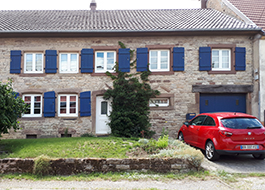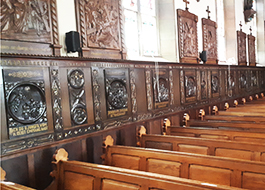Brouviller
Durée visite : 30 minutes
Moyen : Pédestre
Brouviller dépendait de la principauté de Lixheim. Il fut réuni à la France en 1661, par le traité de Vincennes. Signé par le duc de Lorraine et le cardinal Mazarin, premier ministre de Louis XIV, il restitue à Charles IV le duché de Bar. En échange, celui-ci cède à la France un corridor de 2,5 km, entre Metz et Strasbourg. Cette route permettait aux armées royales de rejoindre l’Alsace, française depuis 1648. D’après le généalogiste Jean-Louis Beaucarnot, Brouviller serait le lieu d’origine des ancêtres d’Hillary Clinton.
Brouviller depended on the principality of Lixheim. It was reunited with France in 1661 by the Treaty of Vincennes. Signed by the Duke of Lorraine and Cardinal Mazarin, Prime Minister of Louis XIV, it restores the Duchy of Bar to Charles IV. In exchange, it gives France a 2.5 km corridor between Metz and Strasbourg. This road allowed the royal armies to reach Alsace, French since 1648. According to genealogist Jean-Louis Beaucarnot, Brouviller is the place of origin of Hillary Clinton’s ancestors.
Brouviller war abhängig vom Fürstentum Lixheim. Es wurde 1661 durch den Vertrag von Vincennes wieder mit Frankreich vereint. Unterzeichnet vom Herzog von Lothringen und Kardinal Mazarin, Premierminister Ludwigs XIV., gibt es Karl IV. das Herzogtum Bar zurück. Im Gegenzug erhält Frankreich einen 2,5 km langen Korridor zwischen Metz und Straßburg. Diese Straße ermöglichte es den königlichen Armeen, das seit 1648 französische Elsass zu erreichen. Laut dem Ahnenforscher Jean-Louis Beaucarnot ist Brouviller der Herkunftsort der Vorfahren von Hillary Clinton.

De gueules à la colombe d’argent tenant dans son bec la Sainte Ampoule, de trois roses d’or, deux en chef, une en pointe.
Les roses de Lixheim rappellent l’appartenance à cette principauté ; la colombe est l’emblème de saint Rémy, patron de l’église.
Gules a dove Argent holding in its beak the Holy Ampulla, of three roses Or, two in chief, one in base.
The roses of Lixheim recall the belonging to this principality; the dove is the emblem of Saint Rémy, patron saint of the church
Gules, eine Taube Argent, die in ihrem Schnabel die Heilige Ampulle aus drei Rosen hält. Oder zwei an der Spitze, eine an der Basis.
Die Rosen von Lixheim erinnern an die Zugehörigkeit zu diesem Fürstentum; Die Taube ist das Wahrzeichen des Heiligen Rémy, dem Schutzpatron der Kirche.

Les habitants et les habitantes de Brouviller s’appellent les Brouvillerois et les Brouvilleroises.
The inhabitants of Brouviller are called Brouvillerois and Brouvilleroises.
Die Einwohner von Brouviller heißen Brouvillerois und Brouvilleroises.

Les fortes têtes
Selon le sobriquet, octroyé par les localités voisines aux gens de Brouviller, ceux-ci seraient têtus, opiniâtres, procéduriers et ne démordraient pas facilement. Cette qualification a pour origine, paraît-il, un grave différend, survenu il y a 200 ans, entre la Maîtrise des Eaux et Forêts de Sarreguemines et la Communauté de Brouviller.
Il s’agit d’un long et coûteux procès, intenté par la Maîtrise de Sarreguemines aux 500 habitants de Brouviller, aux 77 de St. Jean et aux 350 de Hommarting dans lequel tous avaient été condamnés le 10 juillet 1771 par 110 ( ! ) sentences différentes, à de fortes amendes, se portant en principal à 1.885 livres, 9 sols, 1 denier cours de France, non compris pour les expéditions et significations 1.098 livres, 14 sols, 2 deniers : en tout : 2.984 livres.
Au mois de juin 1772, les habitants, ayant interjeté appel contre ces sentences multiples, un des résultats obtenus fut la réglementation de leurs droits dans la forêt dite de Schwangen, faite par le Conseil d’Etat le 20 août 1776. Malgré tout ceci, ce fut un coup fatal pour toute la communauté de constater qu’elle fut privée de 700 arpents de cette forêt et du droit d’y aller vain – pâturer avec leurs bestiaux. Cette forêt, qui aujourd’hui a environ 178 ha., appartient à l’Etat.
Réf. Dusanus, Volkshumor
The strong heads
According to the nickname, granted by the neighboring localities to the people of Brouviller, they would be stubborn, stubborn, procedural and would not give up easily. This qualification originates, it seems, in a serious disagreement, which arose 200 years ago, between the Control of Waters and Forests of Sarreguemines and the Community of Brouviller.
It is about a long and expensive lawsuit, brought by the Mastery of Sarreguemines to the 500 inhabitants of Brouviller, the 77 of St. Jean and the 350 of Hommarting in which all had been condemned on July 10, 1771 by 110 (!) different sentences, to heavy fines, amounting in principal to 1,885 pounds, 9 sols, 1 denier cours de France, not including for shipments and notifications 1,098 pounds, 14 sols, 2 deniers: in all: 2,984 pounds.
In June 1772, the inhabitants, having appealed against these multiple sentences, one of the results obtained was the regulation of their rights in the so-called forest of Schwangen, made by the Council of State on August 20, 1776. Despite all this, it was a fatal blow for the whole community to find that it was deprived of 700 acres of this forest and of the right to go there in vain – to graze with their cattle. This forest, which today has about 178 ha., belongs to the State.
Ref. Dusanus, Volkshumor
Die starken Köpfe
Nach dem Spitznamen, den die Nachbarorte den Einwohnern von Brouviller verliehen hatten, waren sie stur, eigensinnig, prozedural und würden nicht so schnell aufgeben. Diese Einschränkung ist offenbar auf eine schwerwiegende Meinungsverschiedenheit zurückzuführen, die vor 200 Jahren zwischen der Wasser- und Waldverwaltung von Sarreguemines und der Gemeinde Brouviller entstand.
Es handelt sich um einen langen und kostspieligen Prozess, den die Herrschaft von Sarreguemines den 500 Einwohnern von Brouviller, den 77 von St. Jean und den 350 von Hommarting vorlegte, in dem alle am 10. Juli 1771 von 110 (!) verschiedenen verurteilt worden waren Strafen zu hohen Geldstrafen im Gesamtbetrag von 1.885 Pfund, 9 Sols, 1 Denier Cours de France, ohne Versand und Benachrichtigungen 1.098 Pfund, 14 Sols, 2 Denier: insgesamt: 2.984 Pfund.
Nachdem die Einwohner im Juni 1772 gegen diese mehrfachen Urteile Berufung eingelegt hatten, wurde unter anderem durch den Staatsrat am 20. August 1776 eine Regelung ihrer Rechte im sogenannten Schwangener Forst erlassen. Es war ein fataler Schlag für die gesamte Gemeinde, feststellen zu müssen, dass ihr 700 Hektar dieses Waldes und das Recht entzogen wurden, vergeblich dorthin zu gehen – um mit ihrem Vieh zu grasen. Dieser Wald, der heute etwa 178 ha groß ist, gehört dem Staat.
Ref. Dusanus, Volkshumor
Les points de visites
.
Ce beau bâtiment en pierre a été très bien restauré . C’était sans doute le logis d’un paysan relativement aisé. A droite, on trouve la travée grange-étable-écurie et, à gauche, la travée habitation. Les greniers ont été transformés en habitations, tout en conservant l’harmonie de l’ensemble (fenêtres, volets)
This beautiful stone building has been very well restored. It was probably the home of a relatively well-to-do peasant. On the right, there is the barn-cowshed-stable bay and, on the left, the dwelling bay. The attics have been transformed into dwellings, while maintaining the harmony of the whole (windows, shutters)
Dieses wunderschöne Steingebäude wurde sehr gut restauriert. Es war wahrscheinlich das Zuhause eines relativ wohlhabenden Bauern. Rechts ist die Scheunen-Kuhstall-Bucht und links die Wohnbucht. Die Dachböden wurden in Wohnungen umgewandelt, wobei die Harmonie des Ganzen erhalten blieb (Fenster, Fensterläden)
.
.
Saint-Rémi date du XVIIIe siècle. Son mobilier est remarquable. Le maître-autel est signé du sculpteur sarrebourgeois Dominique Labroise . Son chemin de croix en chêne est superbe. Les vitraux, dons de paroissiens, sont dus à l’entreprise Thiria, active à Metz avant et après l’annexion de 1871. A l’extérieur, ne manquez pas la jolie grotte mariale. A côté, le monument aux morts est signé du marbrier Kugler. Michel Jung était un Malgré-Nous, mort dans un camp soviétique en octobre 1945, Antoine Jung, autre Malgré-Nous est tué en Galicie en janvier1944, Joseph Jung est tombé en Alsace en décembre 1944, sous l’uniforme français. Ils sont tous les trois mentionnés Morts Pour La France.
Saint-Rémi dates from the 18th century. Its furniture is remarkable. The high altar is signed by the Sarrebourg sculptor Dominique Labroise. Its oak Stations of the Cross are superb. The stained glass windows, donated by parishioners, are due to the Thiria company, active in Metz before and after the annexation of 1871. Outside, don’t miss the pretty Marian grotto. Next to it, the war memorial is signed by the marble worker Kugler. Michel Jung was a Despite-We, died in a Soviet camp in October 1945, Antoine Jung, another Despite-We was killed in Galicia in January 1944, Joseph Jung fell in Alsace in December 1944, in French uniform. They are all three mentioned Morts Pour La France.
Saint-Rémi stammt aus dem 18. Jahrhundert. Seine Möbel sind bemerkenswert. Der Hochaltar ist vom Saarburger Bildhauer Dominique Labroise signiert. Die Kreuzwegstationen aus Eichenholz sind hervorragend. Die Buntglasfenster, die von Gemeindemitgliedern gespendet wurden, stammen von der Firma Thiria, die vor und nach der Annexion von 1871 in Metz tätig war. Im Außenbereich sollten Sie sich die hübsche Mariengrotte nicht entgehen lassen. Daneben ist das Kriegerdenkmal vom Marmorarbeiter Kugler signiert. Michel Jung war ein Trotz-Wir, starb im Oktober 1945 in einem sowjetischen Lager, Antoine Jung, ein weiteres Trotz-Wir, wurde im Januar 1944 in Galizien getötet, Joseph Jung fiel im Dezember 1944 im Elsass, in französischer Uniform. Sie sind alle drei erwähnten Morts Pour La France.







